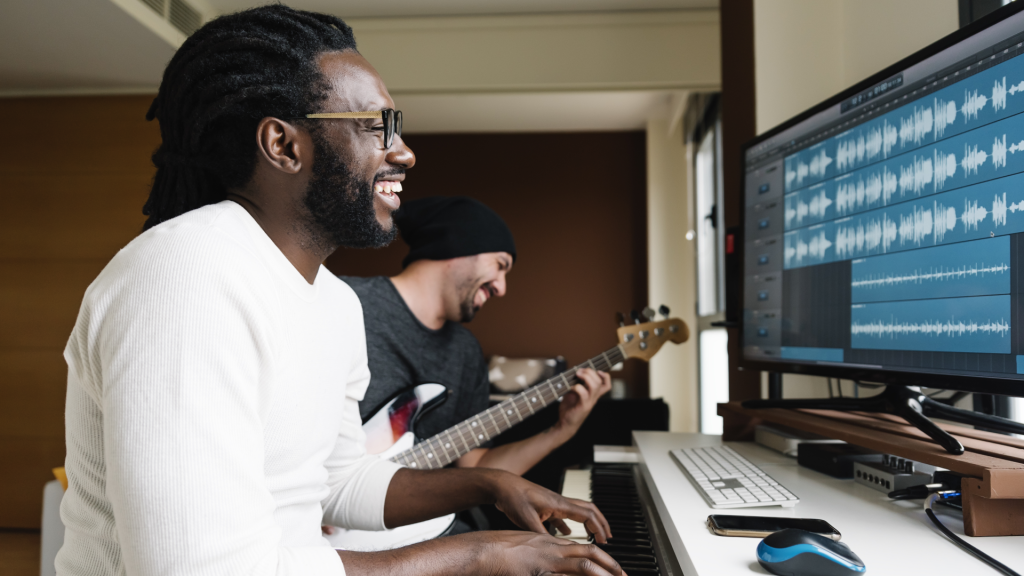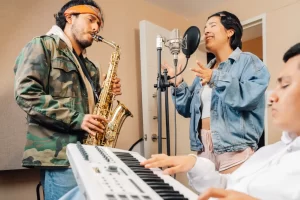As we move deeper into the 21st century, the music industry continues to undergo significant transformations driven by rapid technological advancements. The advent of groundbreaking technologies not only redefines how music is created, produced, and distributed but also how it is experienced by fans around the globe. Today, musicians have at their disposal a suite of innovative tools that can enhance creative processes, streamline production, and open up new avenues for interacting with their audience.
Artificial intelligence, virtual and augmented reality, blockchain, and the Internet of Musical Things (IoMT) are just a few areas where tech innovations are making a profound impact. These technologies are not just fancy gadgets and software but are pivotal in shaping the future landscape of the music industry. They offer exciting possibilities for musicians to break traditional boundaries, whether it’s through AI-assisted composition, immersive virtual concerts, or smarter and more equitable ways to manage rights and royalties through blockchain.
For musicians, staying abreast of these innovations is no longer a luxury but a necessity in a highly competitive environment. Embracing these technologies can lead to new creative heights and more direct and rewarding connections with fans. Furthermore, they hold the promise of greater control over one’s career, from independent distribution and marketing to novel ways of generating revenue such as through digital assets and smart contracts.
This article delves into the latest technological trends reshaping the music industry, offering musicians a detailed guide on how to harness these advancements for their creative and business endeavors. As the digital landscape evolves, so too does the toolkit for the modern musician, promising a future where technology and music continue to enhance each other in dynamic and innovative ways.
AI and Machine Learning
Artificial intelligence (AI) and machine learning are revolutionizing the music industry, offering tools that augment the creative processes of composition, sound engineering, and production. One of the most exciting applications of AI in music is its ability to assist artists in creating compositions. AI-powered software can analyze vast amounts of music data, learning from existing compositions to suggest chord progressions, melodies, and rhythms that fit a particular style or emotion. This not only accelerates the songwriting process but also introduces artists to new musical possibilities that they might not have considered.
Moreover, AI is increasingly being used in sound engineering, particularly in mastering and mixing tracks. Services like Landr use machine learning algorithms to provide automated mastering, delivering professional audio quality that rivals traditional studio work. These AI mastering services analyze the audio and apply dynamic adjustments to different elements, ensuring the track meets industry standards while saving time and resources for artists. The consistency and efficiency of AI in these roles democratize high-quality production, making it accessible to independent musicians who may not have the budget for expensive studio sessions.
The implications of these advancements are profound. They allow musicians to experiment more freely, iterating on AI-generated ideas to refine their sound or explore new genres. It’s important to note, though, that while AI tools offer significant aid, they are best seen as collaborators rather than replacements for human creativity. They provide a starting point from which artists can take the reins, using the AI-generated output as a foundation to add their personal touch and emotional depth. As these technologies continue to evolve, they promise to unlock even more capabilities, making music creation more accessible to novices and offering seasoned artists powerful tools to push the boundaries of what’s possible in music.
Augmented Reality (AR) and Virtual Reality (VR)
Augmented Reality (AR) and Virtual Reality (VR) are two technological frontiers reshaping the music industry by enhancing how artists connect with fans and deliver immersive experiences. Virtual reality, in particular, has opened up new venues for live performances that transcend geographical boundaries. By hosting concerts in virtual environments, artists can reach a global audience from a single location, offering a visually and sonically immersive experience that rivals, and sometimes surpasses, physical concerts. These VR concerts are not only a novelty but provide a genuine sense of presence that can be more inclusive for fans who otherwise might not be able to attend a live show due to cost or distance.
Augmented reality, on the other hand, adds a layer of digital enhancement to the real world, allowing artists to create unique, interactive experiences during live performances. For example, AR can be used to project 3D holograms of performers into the audience, or to overlay visual effects that react to the music in real-time, thereby amplifying the sensory impact of a show. This technology is also being utilized in music videos and promotional materials, providing fans with new ways to engage with music content through their mobile devices. By scanning a QR code or simply pointing their camera at a trigger image, fans can unlock exclusive AR content, from behind-the-scenes footage to augmented merchandise, which can be virtually tried on.
Both VR and AR offer exciting possibilities for fan engagement, pushing the boundaries of how music is experienced. They enable artists to craft unique, memorable events that stand out in a crowded entertainment landscape. Moreover, these technologies are becoming more accessible, allowing more artists to experiment with and incorporate them into their artistic expression and marketing strategies. As these tools evolve, they will undoubtedly continue to transform the concert experience, making it more interactive and personalized, and providing fans with new ways to connect with music and artists in the digital age.
Blockchain and Cryptocurrency
Blockchain technology and cryptocurrency are gaining traction in the music industry, offering transformative solutions to some of the most persistent challenges faced by artists and producers. Blockchain, a decentralized ledger technology, introduces a level of transparency and efficiency previously unattainable in music distribution and rights management. By automating royalty payments through smart contracts, blockchain ensures that artists and all parties involved receive their fair share of earnings promptly and transparently, without the need for intermediaries. This can significantly reduce disputes and delays that often characterize royalty distributions in the traditional music industry setup.
The implications for music distribution are equally significant. Blockchain platforms allow artists to distribute their music directly to listeners, bypassing traditional gatekeepers like record labels and streaming services. This not only increases the revenue artists can earn from their work but also strengthens the connection between musicians and their audiences. Fans can purchase music directly from artists using cryptocurrencies, ensuring that a greater portion of profits goes directly to the creators. This direct-to-fan approach is not just a financial boon but also empowers artists with greater control over their careers and artistic output.
Additionally, the rise of Non-Fungible Tokens (NFTs) has opened new avenues for musicians to monetize their work. NFTs are unique digital assets verified using blockchain technology, which can represent ownership of a specific piece of music, exclusive digital merchandise, or even unique experiences like private concerts. By selling NFTs, artists can create scarcity and value for digital content that would otherwise be easy to replicate and share widely without compensation. This has not only introduced a new revenue stream but has also sparked a wave of creativity in how artists engage with their fans.
Despite the potential benefits, the integration of blockchain and cryptocurrency in music still faces hurdles such as technological complexity and market volatility. However, as these technologies mature and become more user-friendly, they are set to fundamentally reshape the music industry, offering artists unprecedented control and financial independence.
Internet of Musical Things (IoMT)
The Internet of Musical Things (IoMT) represents an exciting evolution in the integration of the internet and digital technologies with musical instruments and devices. This concept extends the capabilities of traditional instruments and equipment by connecting them to the internet, enabling them to communicate with other devices and enhance musical performance and production in innovative ways. For musicians, this means access to a wide array of smart instruments and tools that can significantly alter and improve the way they create and perform music.
Smart musical instruments, a key component of the IoMT, are designed with built-in sensors and connectivity that allow for more intuitive and adaptive performances. For example, guitars and keyboards that can record their output directly to cloud storage, or drums that dynamically adjust their tone and reverb based on the acoustics of a venue, exemplify how these enhanced capabilities can serve both novice and professional musicians. These instruments not only streamline the music-making process but also open up new creative possibilities through features that were once impossible or required extensive manual setup.
Additionally, IoMT extends into wearable technology, which musicians can use to monitor various performance metrics or even control sound effects and other parameters through gestures or body movements. These wearables are not just for performance enhancement but also for health monitoring, helping musicians to track aspects like stress levels and posture, which are crucial for long-term sustainability in performances.
The IoMT also includes software applications that connect various musical devices, creating a seamless network that musicians can control from a central interface. This connectivity enables a level of synchronization and interaction between different pieces of equipment that enhances live performances and studio recordings, making them more dynamic and integrated.
As IoMT technologies continue to develop, they promise to further democratize music production, making sophisticated musical expression more accessible to everyone. By reducing the barriers to entry for high-quality music creation and performance, IoMT is not just transforming the technical landscape—it’s also shaping the future of musical creativity and expression.
Streaming and Social Media Innovations
The landscape of music streaming and social media continues to evolve, presenting new innovations that significantly impact how music is consumed, discovered, and promoted. Streaming services, once merely platforms for listening, are now becoming sophisticated ecosystems that offer artists powerful tools for analytics, engagement, and revenue generation. Innovations in these platforms are designed to enhance the listener’s experience and provide artists with deeper insights into their audience’s preferences and behaviors. This data is invaluable, as it allows musicians to tailor their marketing strategies and creative content more effectively, aligning with the tastes and consumption habits of their fanbase.
Moreover, streaming platforms are increasingly incorporating features that aid in music discovery. Algorithms play a crucial role in suggesting music to listeners based on their past behavior, which can significantly boost an artist’s visibility and listenership. These algorithms are continually refined to become more accurate and personalized, pushing artists to new audiences who are likely to appreciate their work. Some platforms are also experimenting with direct artist-to-fan communications within the app, allowing musicians to share updates, behind-the-scenes content, and exclusive previews directly through the streaming service.
On the social media front, new tools and features are regularly being introduced to help artists maximize their reach and engagement. Platforms like Instagram and TikTok have become integral to music promotion strategies. TikTok, in particular, has revolutionized music marketing by enabling viral music trends that often lead to substantial streaming boosts. The platform’s short-video format is ideal for showcasing catchy snippets of songs, which, combined with creative visuals and engagement from the community, can catapult a track to global popularity.
These social media platforms also facilitate direct and authentic interactions between artists and fans, creating a community around music that is more engaged and personally connected than ever before. As these platforms continue to develop new features, such as live streaming, virtual reality integrations, and interactive media, they provide musicians with an ever-expanding array of tools to creatively share their music and engage with fans. This dynamic interaction not only enhances fan loyalty but also opens up new avenues for artists to express themselves and connect with their audience in real-time.
To Sum It Up
As we explore the latest technological innovations reshaping the music industry, it’s evident that the future holds boundless possibilities for artists and fans alike. From AI and machine learning enhancing creative processes to the immersive experiences offered by AR and VR, these advancements are transforming traditional practices and enabling deeper, more meaningful interactions. Blockchain technology promises fairness and transparency in rights management and distribution, while the Internet of Musical Things and streaming innovations are revolutionizing performance and consumption.
These tools not only empower artists with unprecedented control over their music and careers but also democratize music production and distribution, making it more accessible to independent artists and smaller labels. As musicians navigate this ever-evolving landscape, embracing these technologies can lead to greater creative freedom, enhanced fan engagement, and new revenue streams.
Ultimately, staying informed and adaptable in the face of these changes is crucial for anyone in the music industry. By leveraging these innovative tools, artists can not only refine their craft and business strategies but also forge stronger connections with their audience, ensuring that they remain at the forefront of this digital revolution in music.




